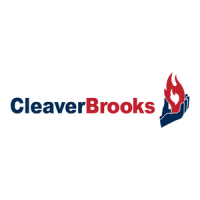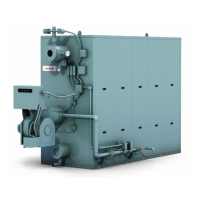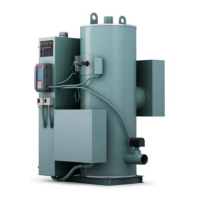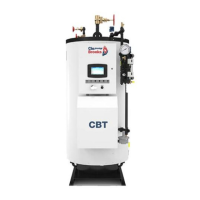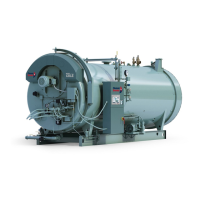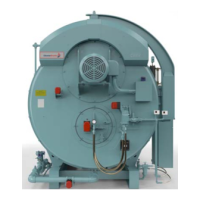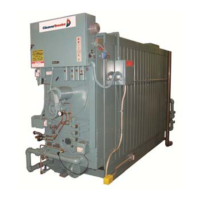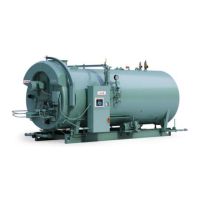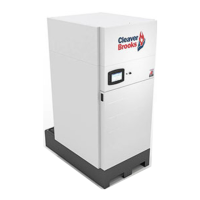Chapter 3 Pressure Vessel Care
3-8 750-177
H. WASHING OUT
Depending on system integrity, feedwater quality, or
operating conditions, the water side of the boiler may need to
be washed out on occasion.
In theory, a hot water system and boiler that have been
initially cleaned, filled with clean, treated water, and with no
makeup water added, will require no further cleaning or
treatment. However, minor system leaks may allow the
admission of additional water or air into the boiler.
Introduction of raw (untreated) makeup water or air to a hot
water boiler may lead to pitting, corrosion, or formation of
sludge, sediment, or scale on the pressure vessel waterside.
The waterside condition of steam boilers can be likewise
affected by feedwater quality, load demands, operating
conditions, or blowdown practices.
The waterside of a hot water or steam boiler should be
cleaned and inspected no later than three months after the
boiler is put into service. Subsequent cleaning of waterside
surfaces should be performed as indicated through periodic
inspection.
In order to thoroughly wash out the waterside of the pressure
vessel, the handhole covers at the ends of the upper and lower
drums must be removed. The interior surfaces of the drums
should be washed with a high pressure hose. Tubes should be
cleaned by directing a high pressure stream of water into the
end of each tube, first from the bottom, and then from the top
drum.
Note: A washout lance for this purpose is
available from your local Cleaver- Brooks
authorized representative.
Control and water column connections on steam boilers
should be checked for accumulated deposits, and cleaned as
required.
After waterside cleaning has been completed, replace the
handhole covers, using new gaskets.
Note: Handhole cover gaskets are installed
dry; that is, without application of a sealing
compound.
I. PERIODIC INSPECTION
Insurance regulations or local codes and good maintenance
will require that the pressure vessel be inspected periodically
by an authorized inspector. Sufficient notice is generally
required to allow removal of the boiler from service and
preparation for inspection. An internal inspection may be
required before cleaning or flushing.
Have the following information available for the inspector:
boiler design, dimensions, generating capacity, operating
pressure and temperature, time in service, defects found
previously, and any repairs or modifications made to the unit.
Reference records of previous inspections also should be
available. Be prepared to perform any testing required by the
inspector, including a hydrostatic test.
When shutting down a boiler, the load should be reduced
gradually and the pressure vessel should be cooled at a rate
that avoids a temperature differential that can cause harmful
stresses. Normally, all pressure should be relieved before a
vessel is drained in order to prevent uneven contraction and
temperature differential that can cause tubes to leak. Draining
the unit too quickly may cause the baking of deposits that
may be present on the heating surfaces.
Note: Check to see that system valves,
feedwater valves, all fuel valves, expansion
tank, and electrical switches are shut off
prior to opening the handholes or the
burner access door. After proper cooling
and draining of the vessel, flush out the
waterside with a high pressure water
stream. Remove any scale or deposits from
the waterside surfaces and check for
internal or external corrosion or leakage.
Fireside surfaces also should be cleaned so that metal
surfaces, welds, joints, tube fittings, and any previous repairs
can be readily checked.
!
DANGER
WARNING
To avoid the hazard of electrical shock,
which could cause serious personal injury
or death, the use of a low voltage flashlight
is recommended during an internal
inspection.
Fireside Inspection
Access for inspection of the firing chamber, or furnace, is
gained through the hinged burner door. Inspection of the
upper pass requires removal of the side casing panels and
second and fourth pass cover plates. Refer to Chapter 7,
Section C, “Fireside Cleaning,” for information regarding
outer and inner casing removal.
Fireside tube surfaces should be checked for corrosion or
accumulation of soot. Use a vacuum cleaner and wire brush
to remove light corrosion or soot.
Localized, heavy corrosion on fireside tube surfaces may
indicate a leaking tube or ferrule connection. If a tube or tube
ferrule leak is indicated, the source of the leakage must be
found and repaired before putting the boiler back in service.
A leak from a tube-to-drum connection may require removal
and reseating of the tube. A heavily corroded or leaking tube
must be replaced in order to assure continued reliable
operation of the boiler. Information regarding tube
replacement can be obtained from your local Cleaver-Brooks
authorized representative.
